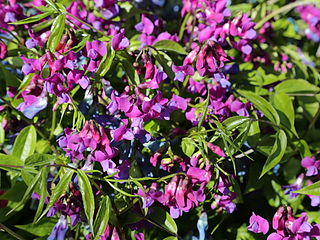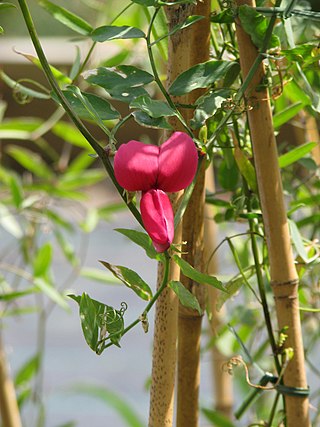
Lathyrus is a genus of flowering plants in the legume family Fabaceae, and contains approximately 160 species. Commonly known as peavines or vetchlings, they are native to temperate areas, with a breakdown of 52 species in Europe, 30 species in North America, 78 in Asia, 24 in tropical East Africa, and 24 in temperate South America. There are annual and perennial species which may be climbing or bushy. This genus has numerous sections, including Orobus, which was once a separate genus. The genus has numerous synonyms, including Pisum, the ancient Latin name for the pea.

Lathyrus sativus, also known as grass pea, cicerchia, blue sweet pea, chickling pea, chickling vetch, Indian pea, white pea and white vetch, is a legume commonly grown for human consumption and livestock feed in Asia and East Africa. It is a particularly important crop in areas that are prone to drought and famine, and is thought of as an 'insurance crop' as it produces reliable yields when all other crops fail. The seeds contain a neurotoxin that causes lathyrism, a neurodegenerative disease, if eaten as a primary protein source for a prolonged period.

Lathyrus pratensis or meadow vetchling, yellow pea, meadow pea and meadow pea-vine, is a perennial legume that grows to 1.2 m in height.

Lathyrus japonicus, the sea pea, beach pea, circumpolar pea or sea vetchling, is a species of flowering plant in the legume family Fabaceae, native to temperate coastal areas of the Northern Hemisphere, and Argentina.

Lathyrus tuberosus is a small, climbing perennial plant, native in moist temperate parts of Europe and Western Asia. The plant is a trailer or weak climber, supported by tendrils, growing to 1.2 m tall. The leaves are pinnate, with two leaflets and a branched twining tendril at the apex of the petiole. Its flowers are hermaphroditic, pollinated by bees. The plants can also spread vegetatively from the root system.

Lathyrus aphaca, known as the yellow pea or yellow vetchling, is an annual species in the family Fabaceae with yellow flowers and solitary, pea-like fruits. It originated in the Middle East and has spread throughout Europe and beyond as a weed of cultivated fields and roadsides. The fruits are eaten as a supplement to diets in some parts of South Asia but are narcotic and potentially toxic in large quantities.

Lathyrus niger, also known as black pea, blackening flat pea and black bitter vetch, is a perennial legume that is native to Europe. Its common name is reference to the blackening of the plant's foliage as it dies.

Lathyrus lanszwertii is a species of sweet pea known by the common names Nevada sweet pea or peavine. It is found in western North America from California to Texas to British Columbia. It is a tender vining perennial which bears lavender, fuchsia, or white pea flowers, and pods containing inedible peas.

Lathyrus sylvestris, the flat pea or narrow-leaved everlasting-pea, is a species of flowering plant in the pea and bean family Fabaceae. It is native to parts of Africa, Europe, and Asia.

Lathyrus vernus, the spring vetchling, spring pea, or spring vetch, is a species of flowering herbaceous perennial plant in the genus Lathyrus, native to forests of Europe and Siberia. It forms a dense clump of pointed leaves with purple flowers in spring, shading to a greenish-blue with age.

Lathyrus hirsutus is a species of wild pea known by several common names, including Caley pea, singletary pea, hairy vetchling, and Austrian winter pea. It is native to Europe, North Africa, and much of Asia, and it is known from other continents, including North America, as an introduced species. This is an annual herb producing a winged stem and leaves each made up of two leaflike leaflets with a branching, coiled tendril. The inflorescence holds one or two pink, blue, or bicolored pea flowers each 1 to 1.5 centimeters wide. The fruit is a dehiscent legume pod covered in hairs with each hair growing from a minute bulbous base. The rest of the plant is generally hairless.
Lathyrus jepsonii is a species of wild pea known by the common names delta tule pea and Jepson's pea. It is endemic to California, where it grows in a number of habitat types, including forest and estuary.

Lathyrus palustris is a species of wild pea known by the common name marsh pea. It is native to Europe, Asia, and North America. It is a perennial herb with leaves made up of oval-shaped or oblong leaflets a few centimeters long. It has branched, coiled tendrils. The plant bears an inflorescence of two to eight pinkish purple pea flowers each up to two centimeters wide. The fruit is a dehiscent legume pod.

Lathyrus polyphyllus is a species of wild pea known by the common name leafy pea. It is native to the western United States from Washington to northern California, where it grows in forest and other habitat. This is a perennial herb with long leaves each made up of many pairs of oval-shaped leaflets a few centimeters long. The leaf also has tendrils which may be long, branched and coiled, or just a short bristle. The stipules are large as well, often over a centimeter wide. The plant produces an inflorescence of up to 12 pea flowers usually arranged in a line along one side of the stem. The flowers are up to 2 centimeters wide and are a variety of shades of purple. The fruit is a dehiscent legume pod containing peas.

Lathyrus splendens is a species of wild pea known by the common names pride of California and Campo pea. It is native to Baja California and its range extends into San Diego County, California, where it grows in the chaparral. This is a climbing perennial pea vine with coiling tendrils. Its leaves are each made up of 6 to 8 linear to oval-shaped leaflets a few centimeters long and wavy-margined stipules. The plant produces showy inflorescences of up to 6 bright to deep red flowers each about 3 centimeters wide. The fruit is a hairless dehiscent legume pod.

Lathyrus sulphureus is a species of wild pea known by the common names snub pea and sulphur pea.

Lathyrus vestitus is a species of wild pea known by the common name Pacific pea. It is native to western North America, where it is mostly found in the forests, woodlands, and chaparral of California. The ranges of some subspecies extend into Oregon and Baja California. This is a perennial pea vine which varies in appearance across subspecies. Leaves are made up of several leaflets of various shapes up to 4 or 5 centimeters long. The leaves usually bear coiling tendrils and the stipules may be large or small. The inflorescence is a showy array of up to 15 pea flowers, sometimes densely packed together, and usually some shade of bright violet, light to medium purple, or white.

Lathyrus sphaericus is a species of wild pea known by the common names grass pea and round-seeded vetchling. It is native to Eurasia and much of Africa, and it is known on other continents as an introduced species. It can grow in many types of habitat, including disturbed areas. This is an annual herb producing a slender stem and bearing leaves each made up of two long, narrow, grasslike leaflets up to 6 centimeters long and a coiling, climbing tendril. The inflorescence is made up of one pea flower on a stalk one or two centimeters long ending a in a bristle. The flower is roughly a centimeter long and deep orange-red or dull red in color. The fruit is a hairless legume pod marked with longitudinal stripes.

Lathyrus linifolius is a species of pea, commonly called bitter vetch or heath pea. The name bitter vetch is also sometimes used for Vicia ervilia and also for Vicia orobus. The tubers of Lathyrus linifolius were formerly used as an appetite suppressant in medieval Scotland, and this use has brought the plant to recent medical attention. Attempts are being made to cultivate the plant on a commercial scale.

Veratrum hybridum is a species of flowering plant in the Melanthiaceae known by the common names slender bunchflower and crisped bunchflower. Many publications use the synonyms Melanthium latifolium and Veratrum latifolium, but the "hybridum" epithet is 9 years older than the "latifolium," so Veratrum hybridum is now the accepted name.



















